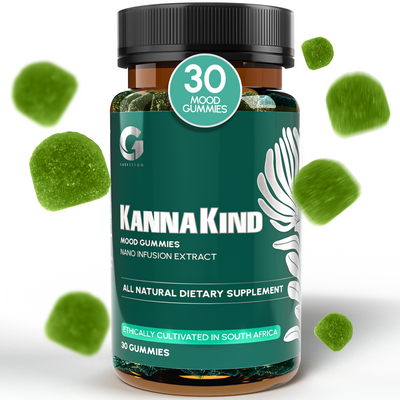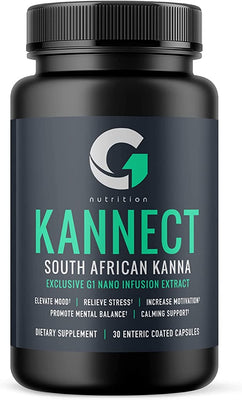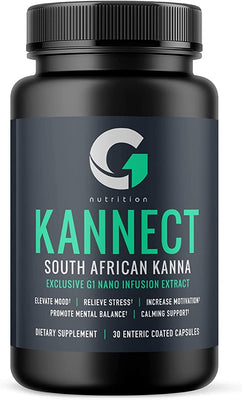For centuries, people have sought natural ways to support their mood, sharpen their focus, and find a sense of calm. One plant that has a rich history of use for these very purposes is Sceletium tortuosum, more commonly known as Kanna. While it may be new to many in the Western world, its story is deeply rooted in tradition and is now being explored through modern research.
This guide will walk you through everything you need to know about this fascinating plant. We will explore its origins, the different forms available, and how to use it responsibly. You will learn about dosage, safety considerations, and what to look for when choosing a quality product. Whether you are just discovering Kanna or looking to deepen your understanding, this Sceletium tortuosum guide provides the essential information for your journey.
What Is Kanna (Sceletium tortuosum)?
Kanna is a succulent plant native to South Africa. It has gained recognition for its potential to support mood and mental well-being. Unlike many other botanicals, Kanna is not known for causing intense psychedelic experiences but is instead appreciated for its more subtle, supportive effects on emotional and cognitive balance.
Origins and Traditional Use
The story of Kanna begins with the indigenous Khoisan and San peoples of Southern Africa, who have used the plant for centuries. Traditionally, these hunter-gatherer and pastoralist communities would ferment the plant's leaves, stems, and roots before chewing them. This preparation method was believed to enhance its effects.
Historically, Kanna was used in social and spiritual ceremonies. It was often taken to relieve thirst and hunger during long journeys, elevate spirits, and promote a sense of connection and well-being within the community. Its mood-enhancing applications made it a valuable part of their culture, long before it was introduced to the wider world.
Modern Popularity
In recent years, Kanna has surged in popularity across the globe as more people seek natural alternatives for mental wellness. Its rise as a natural mood and focus supplement is tied to a growing interest in herbal solutions for managing everyday stress and enhancing cognitive function. Modern science has begun to study Kanna's active compounds, known as alkaloids, to better understand how they interact with the brain to produce their calming and uplifting effects. This has led to the development of standardized extracts and convenient product forms that make Kanna more accessible than ever before.
Forms of Kanna You Can Use
Kanna is available in several different forms, each offering a unique experience in terms of preparation, onset, and convenience. Understanding these options can help you find the best fit for your lifestyle and wellness goals.
Powder
Raw or fermented Kanna powder is one of the most traditional forms. It is made by drying and grinding the plant material. The taste is often described as earthy and slightly bitter. Kanna powder can be mixed into drinks, brewed as a tea, or even taken directly. Its bioavailability can vary depending on how it's consumed, with some users finding it less potent than concentrated extracts.
Extracts and Concentrates
Kanna extract is a more modern and potent form. Extracts are created by isolating the active alkaloids from the plant material, resulting in a concentrated product. This process allows for standardization, which means the concentration of key alkaloids, like those in the mesembrine family, is consistent from batch to batch. This provides a more predictable and reliable effect. Extracts are often the basis for many commercial Kanna products due to their potency and consistency.
Tea and Infusions
Making Kanna tea is a simple and traditional way to enjoy its benefits. This method involves steeping Kanna powder or crushed leaves in hot water. The effect profile of Kanna tea is often described as gentler and more relaxing compared to other methods. It provides a soothing ritual and a mild introduction to the plant's supportive properties, making it a good starting point for beginners.
Capsules and Tablets
For those seeking convenience and precise dosing, capsules and tablets are an excellent choice. They contain a measured amount of Kanna extract or powder, eliminating any guesswork. This form is tasteless, easy to take on the go, and ensures you receive a consistent level of active alkaloids with every serving. Capsules are a popular choice for daily use to maintain a steady sense of balance and focus.
Tinctures and Sublinguals
Kanna tinctures are liquid extracts, usually with an alcohol or glycerin base. They are taken by placing a few drops under the tongue (sublingually). This method allows for fast absorption directly into the bloodstream through the mucous membranes in the mouth. As a result, the effects can be felt more quickly than with ingested forms like capsules or tea. Dosing with tinctures requires careful measurement using the provided dropper.
How to Choose a Quality Kanna Product
With the growing popularity of Kanna, the market is filled with products of varying quality. Knowing what to look for is crucial to ensure you are getting a safe, effective, and authentic product.
Purity and Testing
Reputable suppliers prioritize the purity and safety of their products. Look for brands that provide a Certificate of Analysis (COA) for their Kanna. A COA is a document from a laboratory that confirms the product has been tested for contaminants like heavy metals, pesticides, and microbes. Third-party testing, where an independent lab verifies the product's contents, adds an extra layer of trust and transparency.
Alkaloid Standardization
The effects of Kanna come from its unique profile of alkaloids, with the mesembrine family being the most studied. A quality Kanna product will be standardized to a specific percentage of these alkaloids. Standardization ensures that each dose delivers a consistent and predictable amount of the active compounds. Without it, the potency can vary wildly between batches, leading to an unreliable experience. High-quality extracts will clearly state the alkaloid content on the label.
Reputable Brands and Suppliers
Choosing a reputable brand is one of the best ways to ensure you are buying Kanna that is both safe and effective. Established suppliers are more likely to follow good manufacturing practices (GMP) and have a transparent sourcing and testing process. Be cautious of products that make unrealistic claims, lack information about their sourcing or testing, or are sold at unusually low prices. These can be red flags for low-quality or even adulterated products.
Featured Products
Dosage Guidelines and Cycling
Finding the right Kanna dosage is a personal process that depends on the form you use, your body chemistry, and your desired outcome. It is always best to start with a low dose and gradually increase it until you find what works for you.
Recommended Doses
Dosage can vary significantly between different forms of Kanna. The following are general guidelines, but you should always follow the recommendations on your product's label.
- Powder: A common starting dose for Kanna powder is around 100-250 mg. Some experienced users may take more, but starting low is key.
- Extract: Standardized extracts are much more potent. A typical dose might range from 25-50 mg, depending on the concentration.
- Capsules: Capsules offer pre-measured doses, often containing between 25 mg and 100 mg of Kanna extract. Start with the lowest available dose.
- Tinctures: Dosage for tinctures depends on their concentration. A typical starting point might be a few drops to 0.25 mL.
Cycling and Tolerance
Some users report that daily, long-term use of Kanna can lead to a build-up of tolerance, meaning a higher dose is needed to achieve the same effects. To avoid this, some people practice cycling. A common cycle might involve taking Kanna for five days, followed by a two-day break. This practice can help maintain the plant's effectiveness over time. Listening to your body is the most important part of using Kanna safely and sustainably.
Onset and Duration of Effects
How quickly you feel the effects of Kanna and how long they last depends heavily on the form you use.
- Sublingual (Tinctures): Effects are often felt within 15-30 minutes and can last for 1-2 hours.
- Ingested (Capsules, Tea, Powder): Onset is slower, typically taking 45-90 minutes as the Kanna passes through the digestive system. The effects may last longer, around 2-4 hours.
Many users report that the full benefits of Kanna, particularly for mood support, build up over several days of consistent use.
Safety, Side Effects, and Precautions
Kanna is generally considered safe when used responsibly and at appropriate doses. However, like any supplement, it is not without potential side effects and interactions. Being informed is essential for a positive experience.
Common Side Effects
Side effects from Kanna are uncommon and usually mild, often occurring with higher doses. They can include:
- Headache
- Mild nausea or upset stomach
- A feeling of overstimulation or restlessness
These effects typically diminish as your body adjusts or if the dose is lowered. If you experience any persistent adverse effects, you should discontinue use and consult a healthcare professional.
Drug Interactions and Contraindications
This is the most critical safety consideration. Kanna is believed to act as a serotonin reuptake inhibitor (SRI). This means it can interact with other substances that affect serotonin levels in the brain.
You should NOT take Kanna if you are taking any of the following:
- SSRIs (Selective Serotonin Reuptake Inhibitors): Such as fluoxetine, sertraline, or escitalopram.
- MAOIs (Monoamine Oxidase Inhibitors): A class of antidepressants.
Combining Kanna with these medications can lead to a dangerous condition called serotonin syndrome. Always consult with your doctor before trying Kanna if you are on any prescription or over-the-counter medication.
Who Should Avoid Kanna
Certain individuals should avoid using Kanna due to a lack of safety research in these populations. This includes:
- Individuals who are pregnant or nursing.
- Anyone under the age of 18.
- Those with known or suspected medical conditions, especially related to heart health or blood pressure.
As with any herbal mood support supplement, consulting your doctor before you begin is a responsible first step.
Legal Considerations
In the United States, Sceletium tortuosum (Kanna) is federally legal to buy, possess, and use as a dietary supplement. It is not a controlled substance. However, regulations can vary by country, and it is important to check the laws in your specific location before purchasing or importing Kanna.
The sale of Kanna is regulated by the FDA, which means brands are not allowed to make unsubstantiated medical claims about their products. Any language suggesting that Kanna can diagnose, treat, cure, or prevent any disease is prohibited. Reputable brands will use compliant language, focusing on support for general well-being, mood, and focus.
Summary and Practical Tips
Kanna offers a unique, natural way to support a balanced mood and a clear mind. From its traditional roots in South Africa to its modern forms like capsules and extracts, it provides a versatile option for those exploring herbal wellness.
To get started, choose the right form for your needs, whether it's the convenience of capsules or the rapid onset of a tincture. Always select a product from a reputable brand that values purity, standardization, and third-party testing.
Begin with a low dose and listen to your body, adjusting as needed. Remember the critical safety precautions, especially regarding interactions with SSRIs and MAOIs. By managing your expectations and integrating Kanna responsibly, you can safely explore the benefits this ancient plant has to offer.



